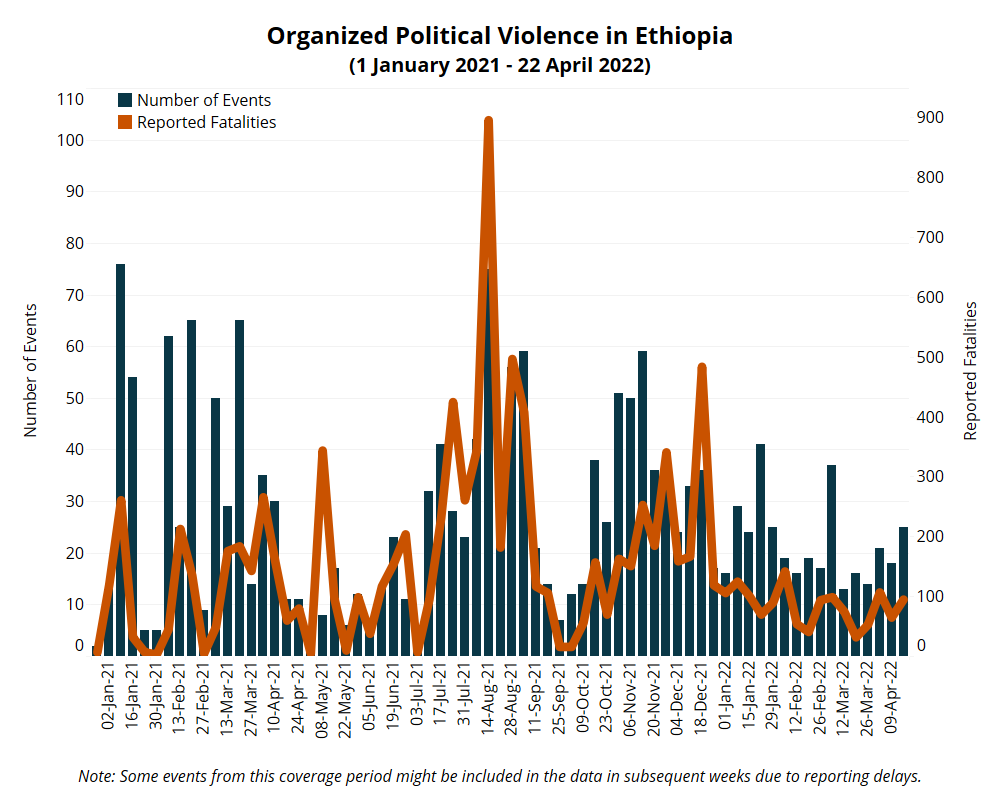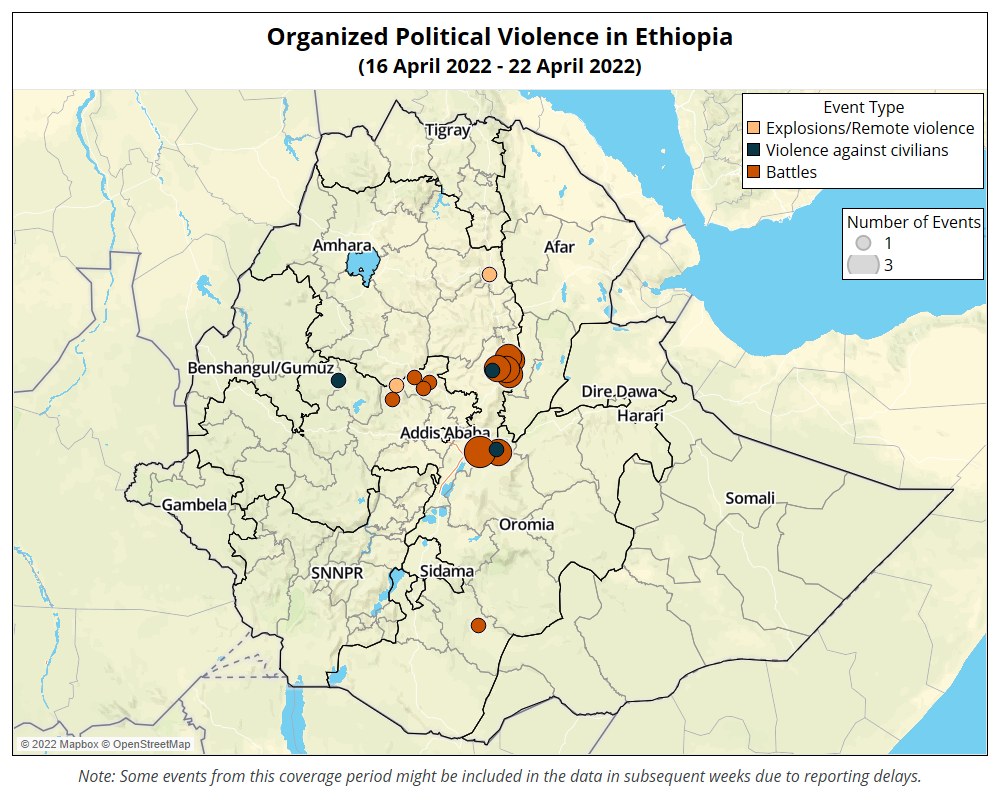By the Numbers: Ethiopia, 2 April 2018-22 April 2022 1Figures reflect violent events reported since Prime Minister Abiy Ahmed came to power on 2 April 2018.
- Total number of organized violence events: 2,875
- Total number of reported fatalities from organized violence: 15,781
- Total number of reported fatalities from civilian targeting: 7,152
By the Numbers: Ethiopia, 16-22 April 2022 2Some events from this coverage period might be included in the data in subsequent weeks due to reporting delays.
- Total number of organized violence events: 25
- Total number of reported fatalities from organized violence: 95
- Total number of reported fatalities from civilian targeting: 5
Ethiopia data are available through a curated EPO data file as well as the main ACLED export tool.

Situation Summary
Last week, on 17 and 18 April, Fano and Amhara ethnic militias clashed with the Oromo Liberation Front (OLF)-Shane and Oromo ethnic militias in areas bordering North Shewa and Oromia special zones in Amhara region. In North Shewa zone, armed clashes were recorded in Zembo, Addis Alem, and Negeso kebeles in Efratana Gidem woreda, and Kewet in Menze Mama Midir woreda (see map below). In Oromia special zone, fighting occurred in Wesen Kurkur, Mute Facha, and Tikure Wadawo in Jilye Tumuga woreda. The Weekly Focus delves deeper into these events. In addition, on 20 April, a buried tank shell detonated in Woldiya town in North Wello zone, injuring one civilian.

In Oromia region, armed clashes between OLF-Shane and government forces continued. Last week, battle events were recorded in East Shewa, North Shewa, West Shewa, and Guji zones. On 19 and 20 April, OLF-Shane militants clashed against Ethiopian National Defense Force (ENDF), federal police, and Oromia regional special forces in various parts of Boset woreda, including Bole and Welenchiti towns, in East Shewa zone. In Bole town, 12 civilians were reported killed, while casualties in other conflict-affected areas of Boset woreda are unknown. On 17 April, the OLF Shane ambushed an ENDF military convoy in Hidabu Abote woreda in North Shewa zone, resulting in an unknown number of fatalities. Four days later, the two conflicting parties also clashed in Ose in Wara Jarso woreda and Daye Wilincho in Kuyu woreda in North Shewa zone. The OLF-Shane claimed to have killed eight and injured 15 soldiers in Ose, and in Daye Wilincho, the group claimed to have killed 15 and injured 20 others (OMN, 23 April 2022). This claim could not be independently confirmed. On 20 April, the OLF-Shane fought against ENDF and Oromia regional special forces in Ginde Beret woreda in West Shewa zone, reportedly leaving an unidentified number of people dead. The next day, a reported drone-assisted airstrike by the ENDF on OLF-Shane targets in Dogoma Kibi kebele in Abuna Ginde Beret woreda in West Shewa zone resulted in an unknown number of fatalities. In Guji zone, the OLF-Shane clashed with ENDF and Oromia regional special forces in Harkelo in Gora Dola woreda. The group claimed to have killed 26 and wounded 29 soldiers (OMN, 21 April 2022). However, this claim could not be independently verified.
Two attacks against civilians involving Fano militias were recorded in Oromia region last week. On 18 April, suspected Fano militiamen stopped an ambulance in Kawa Gebeya kebele in Boset woreda in East Shewa zone. They dragged three health workers and the driver out of the car and beat them, and then destroyed the ambulance. Moreover, last week, Amhara ethnic militia and Fano militia members opened fire on civilians, burned farmers’ homes, looted several heads of cattle, and killed an unknown number of people in Burka Sorema in Kiremu woreda in East Wollega zone (OBN,18 April 2022).
A number of protests against the OLF-Shane were also recorded in Oromia region. On 18 April, residents of Ameya woreda gathered in Gindo town in South West Shewa zone to condemn the attacks on civilians by the OLF-Shane. The next day, a similar protest was held by residents of Ada Berga woreda in Inchini town in West Shewa zone.
Weekly Focus: Clashes Re-ignite in Oromia Special Zone and Surrounding Areas in Amhara Region
Oromia special zone in Amhara region is one of the most consistently violent locations in Ethiopia. Since 2018, several rounds of violence have erupted in the area, resulting in the destruction of infrastructure, displacement of civilians, and loss of life. As an important location along the A2 highway, the area is subject to historical claims by the Amhara, Oromo, and Afar ethnic groups. Violence over the past week represents another escalation in worsening tensions between Amhara and Oromia regions (see EPO Weekly: 9-15 April 2022 for more information on the most recent round of fighting).
Oromia special zone of Amhara region was founded as a response to pressure from the OLF, which had been demanding autonomy for the Oromo-speaking population during the early transition period from 1991 to 1992 (Sarah Vaughan, 2003). Since then, competing claims over the territory and its administration by ethnic Oromos, under Amhara region, have been the basis for regular conflicts. Furthermore, conflict over pasture between ethnic Oromo and Afar pastoralists is also frequent.
Last week, clashes re-ignited at the border areas of North Shewa and Oromia special zones in Amhara region. In Oromia special zone, fighting occurred in Wesen Kurkur, Mute Facha, and Tikure Wadawo in Jilye Tumuga woreda. In North Shewa zone, armed clashes were recorded in Zembo, Addis Alem, and Negeso kebeles in Efratana Gidem woreda, and Kewet in Menze Mama Midir woreda. There are competing claims about the actors involved and who initiated the armed clashes, with reports indicating that at least 20 people were killed and 48 others injured as a result of fighting in these woredas. In North Shewa zone, 125 houses were burned and more than 3,000 people were forced to flee their residences, while in Oromia special zone, an unknown number of people from three kebeles were internally displaced (DW Amharic, 21 April 2022).
Destruction of infrastructure due to clashes was most serious in Molale village in Zembo kebele in Efratana Gidem woreda in North Shewa zone. The main road connecting the capital city, Addis Ababa, to Dessie town was closed for several days due to ongoing fighting. Public institutions and business centers in Shewa Robit town along the main A2 highway were also closed. Amhara regional special forces and the federal police were involved to control the armed clashes. At least two members of Amhara regional special forces were killed by one of the warring parties during an operation to control the clashes. According to the Efratana Gidem woreda administrator, fighting erupted after the OLF-Shane attacked and killed one farmer in the woreda. This account was refuted by the head of the Jilye Tumuga woreda communication who blamed Fano militias for shooting at herders in the woreda (BBC Amharic, 21 April 2022). Previously, in April 2021, the OLF-Shane and local Oromo militias attacked Ataye town, the capital of Efratana Gidim Woreda, and surrounding areas. Due to frequent conflicts in the area, Ataye town is completely destroyed (see EPO Weekly: 10-16 April 2021 and EPO’s Conflict Profile page Kemise Conflict for more details on the tensions between North Shewa and Oromia special zones in Amhara region).
Renewed conflict in areas surrounding Oromia special zone in Amhara region is a microcosm of the rest of Ethiopia, where conflicting claims over territory, national direction, and ethnic homeland claim all intersect. According to some reports, ethnic Oromo residents in the area believe that armed groups from neighboring Amhara areas are insisting that Oromia special zone be dismantled (Addis Standard, 19 April 2022). Competition between armed groups from Oromia and Amhara regions is one of the most dangerous trends in the country today.
As fighting in Ethiopia’s north between TPLF and federal government forces has decreased, other smaller conflicts have resurfaced throughout Ethiopia. While these smaller conflicts are in most cases over territory and resources, larger political conflicts are also at play. Over the next few years, Ethiopians will decide their national direction, method of governance, and internal boundaries through the established National Dialogue Commission. The conflicts in contested areas, like Oromia special zone in Amhara region, are likely to be subjects of political debate and escalated fighting is to be expected unless a fair and transparent decision-making process is established.






